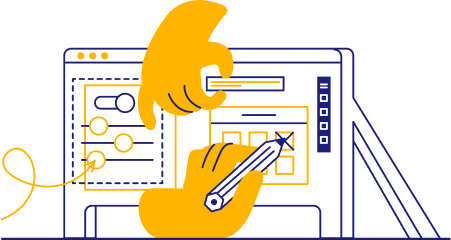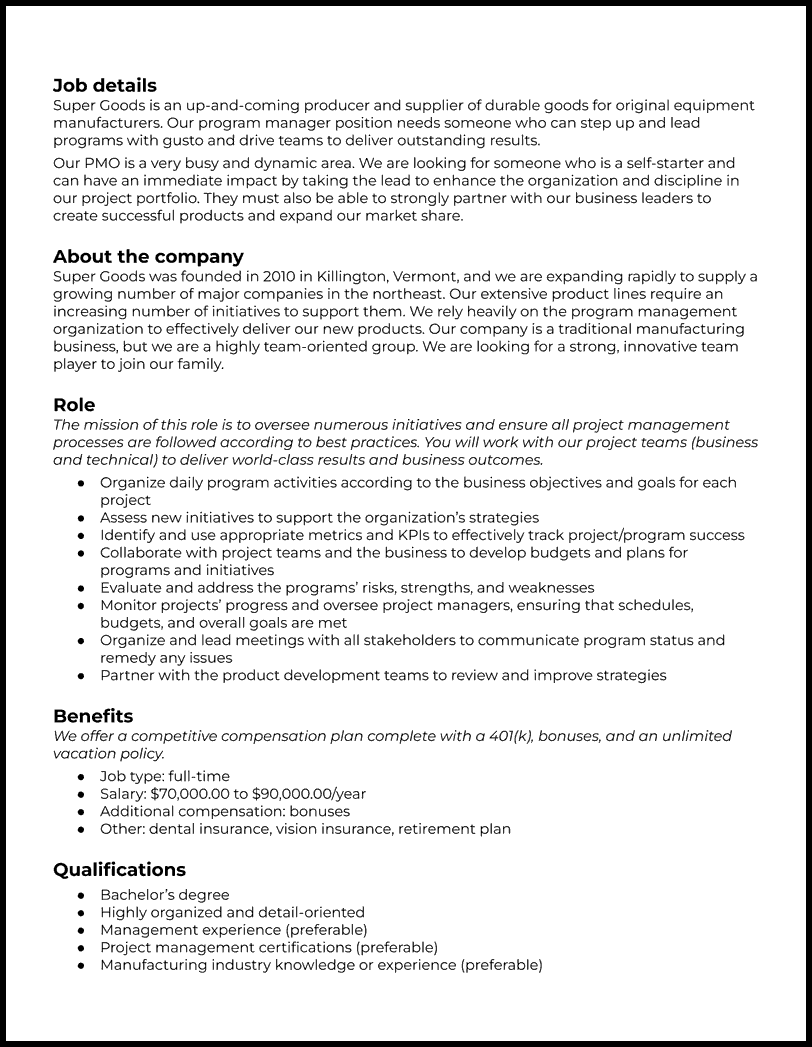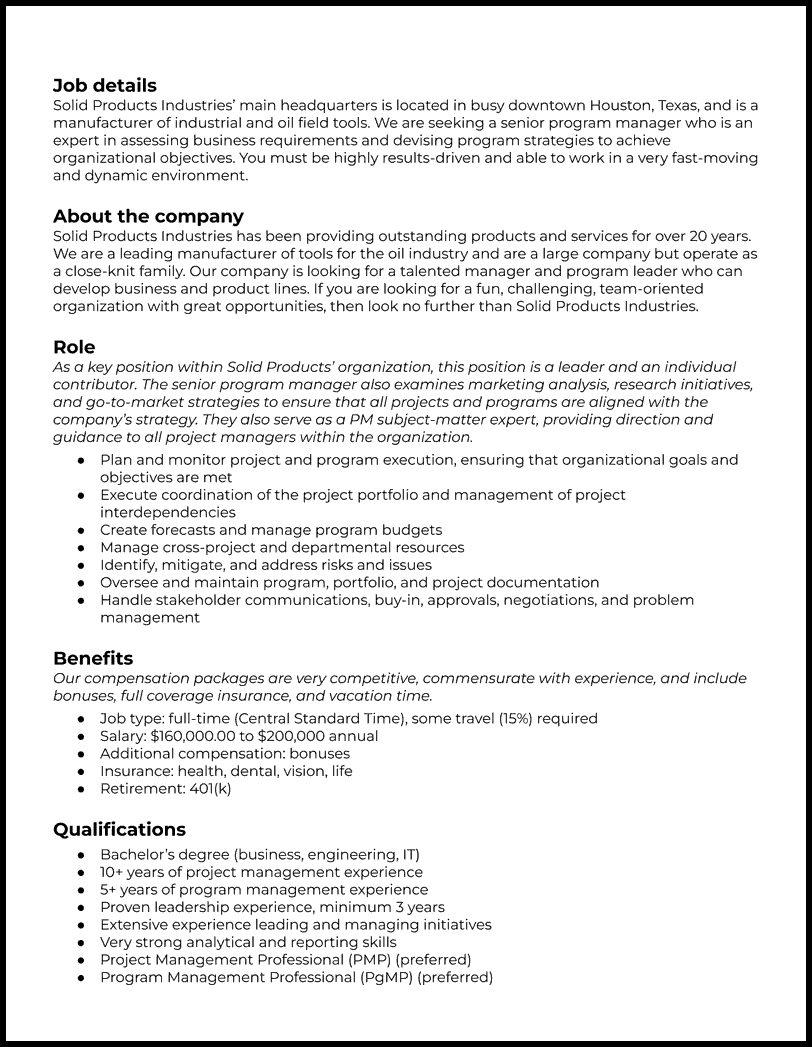Hiring a program manager isn’t a walk in the park. After all, they’re responsible for creating and maintaining the policies & procedures for your company, so you want to make sure they’ve got the right skills for the job and fit in well with your company’s culture.
Recruiting an outstanding program manager can be a tough and frustrating process, from filtering through program manager resumes to interviewing a host of candidates. That’s why we’re here to help!
If you’re stuck on how to write a program manager job description, this is the right place to be. Browse our job description examples and writing guide so you can attract and hire the best person (or people) for the job.
Why this job description works
- When writing your job description, consider what you’d want to know if you were the one applying for the job.
- Paint an accurate picture of the interpersonal work dynamic, the company’s scale, the company culture, and daily responsibilities for the specific job.
- Spice up your job description with a little bit about the organization itself on a higher level. The best candidates for your company are those who resonate with your mission statement.
- Including a touch of company history (just a touch, mind you) will show applicants what you’re about and clarify your vision.
Why this job description works
- Demonstrating your company’s culture in your job description is an awesome way to attract candidates who will mesh well with your existing team.
- Applicants will need to know how to tailor their resume to your job posting, so take this opportunity to exemplify your company’s personality!
- For example, if the company culture is casual, but the role is technical, include technical phrases but a casual tone in your technical program manager job description.
- Let applicants know your expectations right away, so bulleted lists are your best friend.
- It may feel more “unprofessional” than full sentences, but bullet points are easier to read (plus they’re easier to write).
Why this job description works
- Unless you’re hiring for a purely remote position, including the location in your senior program manager job description is crucial.
- Even if you are hiring for a remote role, sharing your location can tell candidates more about your local customer or client base’s needs.
- For senior positions, listing benefits is essential to attract a high-quality hire.
- Including a benefits section not only entices applicants to apply, but it also gives them a heads-up on the company’s culture and values, helping them decide how to write their resume.
Write Your Best Program Manager Job Description

Writing a job description isn’t easy. This goes for any role, but it can be especially difficult for the program manager role because it covers such a large set of skills that can vary from company to company.
Brevity is paramount. Job seekers tend to skip job descriptions that are long—or even worse, they’ll skim and miss key points. So, make sure to include information regarding how your job and/or company is unique, but keep the overall description short. The goal is to sell the job and your organization to the reader. You want to make them want that job!
One of the best ways to describe what a job role requires is to give examples of issues a program manager would handle. Or, you can explain why you’re hiring for the job or describing a gap that needs to be filled. Be specific.
The goal is to sell the job and your organization to the reader.
Although it’s tempting, avoid listing too many job requirements. Having a long list has been shown to lower the diversity of the candidates that will apply (and it’s just plain annoying to read). To encourage diversity better, use wording that won’t reinforce preconceived biases in your job description.
All in all, your goal should be to write concisely.Writing concisely can be a tough skill to master, but it’s especially significant with job postings. Choose your words wisely, and make sure they’re clear and understandable..
The last step in creating a great job description is proofreading. Ideally, you should get one or more people in program management to check it over. There’s nothing worse than posting a job description with bad wording, grammatical errors, or inaccurate information such as a salary range with one too many zeros.
If you can, let your program manager job description sit for a day or two before looking at it again with fresh eyes. Taking the extra time to make sure your job description is right will ensure that you attract high-quality talent.
Outline Your Program Manager Job Description

Crafting your job description doesn’t have to be a painful endeavor. We all need a place to begin. Below is an outline that covers the items for a program manager job description. You’re welcome to copy the outline and fill it in according to the specific role you want to fill.

Job details
Use this section as an introduction to your job opening and the company. Leverage this area to promote the role and organization. Don’t make it too long. (You’ll have an opportunity later to provide more company information.)
You should provide one or two sentences describing the what and why of the program manager role. Also, give the candidate a quick snippet of why your company is great. Again, you’re trying to attract the best people to this role. Give them something that will make them want the job.

About the company
This is where you need to sell your company and make the reader interested in working there. Provide some details, perhaps about the history or culture of the company, but make sure they’re relevant to the role.
A program management professional is going to want to know about the company’s project management and business strategies. Include a sentence or two with a synopsis of how the company approaches projects and initiatives in its strategy and how the program manager role fits in.

What you’ll be doing
Whatever this section is called, here’s where you create a bulleted list of the most significant tasks that the person in this job will perform. Be concise and clear, because a candidate who takes time to customize their program manager cover letter will address the roles you want to fill.
Be sure to have anything unique and critical to your program manager role. You should always use active verbs, be as specific as possible, and avoid using filler words.
- Organize programs and initiatives to support the organization’s mission, goals, and objectives
- Develop new programs to drive strategic initiatives and business processes
- Create and manage long-term goals for development efforts
- Implement and manage scope changes and issues to ensure project goals are achieved
- Meet and facilitate decision-making with stakeholders on a regular basis to ensure clear and transparent communication regarding project issues
- Produce complete, accurate, and timely reporting of program and project statuses throughout their life cycles

Qualifications
This section is critical because it’s where the applicant will decide whether they’re a good fit. Typical things to include are education, experience, certifications, and specialization requirements. Ensure you’ve listed all the requirements that are deal-breakers. While it’s okay to list preferred qualifications, label them as such and avoid going overboard.
When referring to soft skills, use relevant personality words but avoid using too many. A program management role will have many standard requirements, but don’t waste valuable space listing generic skills. Do make sure to include non-standard qualifications your company may need.
- Bachelor’s degree (business, engineering, IT)
- 10+ years of project management experience
- 5+ years of program management experience
- Proven leadership experience, minimum 3 years
- Excellent knowledge of software development and methodologies (Waterfall, Agile)
- Experience managing designers, developers, and programmers
- Certified Associate in Project Management (CAPM) or Project Management Professional (PMP)

Benefits
Your goal here is to make the program manager position as attractive as possible. Always be specific, clear, and short with your benefits list, but make sure you include all of them.
You probably shouldn’t open with the benefits, but you can put them anywhere else in the job description. If your company has something unique or special about its benefits, definitely highlight those, and (if this is the case) you may want to list this early on in the job description.
Program Management Roles and Functions

Program managers are masters of managing schedules and groups of people to complete tasks. The program manager must be able to efficiently juggle many tasks and resources at one time.
Below are sample roles a program management professional might fulfill on the job. One single program manager may not fulfill all these functions or roles, but this will give you some inspiration regarding what you can include:

High-level management and leadership
A program manager must have some level of management experience. They must also be very adept at not only managing projects but very strong at overseeing individual staff members and cross-functional teams.
- Supervise direct and indirect reports and other project resources
- Manage highly matrixed and offsite teams with diverse backgrounds and skill sets

Scheduling and managing tasks
Program management moves to the next level of complexity due to the increased number of initiatives and projects managed as a program and/or portfolio, so your program manager must be able to manage their time effectively.
- Create and maintain complex schedules, tasks, and status updates for multiple resources, teams, and external vendors
- Assess and document technical and business efforts at a sufficient level of detail to clearly convey each task in a way that it can easily be understood and tracked

Conflict resolution & problem-solving
Related to possessing strong people management skills, a good program manager must also be able to identify and resolve conflicts as well as deal with issues and problems as they arise.
- Collaborate with stakeholders to recognize challenges before they become issues
- Proactively manage issues and problems to minimize project impacts

Risk management
Risk management is a key function within project management, and a program manager must excel in this area. They need to identify, document, and address anything that may impact a project/program.
- Work closely with stakeholders to proactively recognize both negative and positive events that could impact a project
- Devise mitigation plans to minimize the impact of identified risks

Cost control and budgeting
One of the more difficult areas for most program managers is overseeing the budgetary aspects of projects. Having the financial acumen to manage all costs associated with projects and programs is a very beneficial skill to have.
- Create, maintain, and report on project budgets, forecasts, and actual results
- Assess and address budgetary impacts due to project changes

Teamwork and motivation
Program managers must complete the tricky skill of working with stakeholders to effectively and efficiently complete project tasks. They should be able to persuade and enable people, who may not even directly report to you, to get things done to achieve project objectives and goals.
- Apply technical and business knowledge/expertise to evaluate quality and progress on tasks
- Guide, inspire, and/or persuade project resources to complete tasks on schedule, with quality, and within budget

Organization and multitasking
Multitasking is an overused term, but it’s truly relevant to project and program management since PMs must handle multiple projects simultaneously. This stretches individual and team capacity management to the maximum level, but a great program manager can help it go smoothly.
- Collaborate with many people (teams, departments, vendors, clients, etc.) to resolve business and personality conflicts
- Optimize scheduling and levels of effort for many disparate activities across multiple workstreams

Communication
Communication is a key skill for many roles, but it’s especially important to a program manager because it is a prerequisite for almost all the previously mentioned roles and abilities.
- Leverage all media and forums such as meetings, presentations, e-mails, phone calls, and virtual meetings
- Communicate succinctly and clearly in all scenarios and especially when conveying technical processes to business process owners, management, and executives








